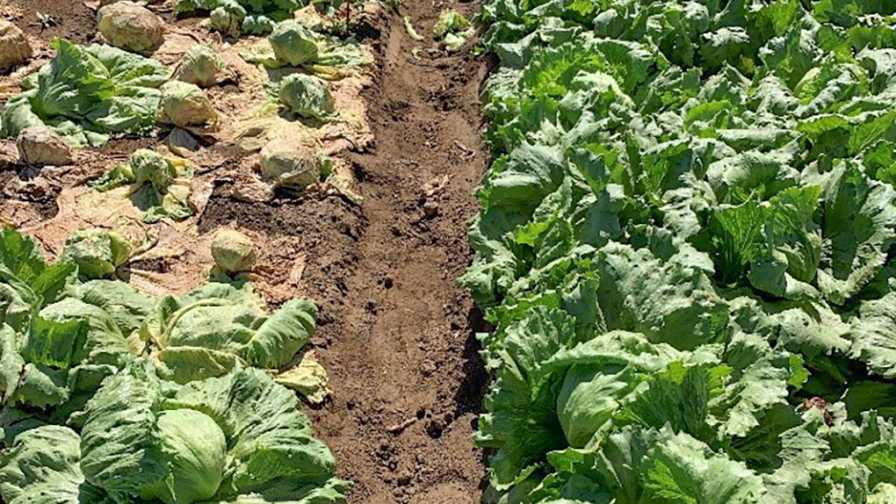Is America’s Salad Bowl Facing a New Normal?
There is no disputing that 2020 will go down in the history books as one of the most challenging for all the obvious reasons, the devastating pandemic notwithstanding. In addition to all the issues raging in the U.S., the Salinas Valley struggled with a few more: wildfires in the hills above the valley; maintaining a healthy workforce; two significant hot spells; and two significant diseases affecting lettuce — impatiens necrotic spot virus (INSV) and Pythium wilt.
The wildfires here made national news but fortunately did not greatly impact the vegetable production fields down on the valley floor. The fires caused some temporary disruptions of traffic on roads at the base of the hills where the fires burned.
Evacuations and the unfortunate loss of homes had a bigger impact.
When COVID-19 emerged as a problem, growers quickly adjusted policies to keep field and packinghouse workers properly distanced. Fortunately, worker health was not a major constraint to growing or harvesting the crops, for the most part.
Heat Wave a Harbinger?
The occurrence of hot spells is concerning because it threatens the Salinas Valley’s unique climate. Here, moderate temperatures prevail in the summer, allowing us to grow cool-season vegetables and berries.
The “heat dome” that developed over the Western U.S. and spurred wildfires also brought unprecedented high temperatures (above 105°F). In To cope with these conditions, growers applied extra irrigation to ensure plants did not lack for water during the extreme-temperature days.
The high temperatures caused sporadic quality problems and reduced yields. It is not clear if the sporadic heat spells portend a new-normal for the West related to climate change, but it is a concern moving forward.
Double Whammy Diseases
Following the heat spells, outbreaks of Pythium wilt (Pythium uncinulatum) began in lettuce fields in the northern part of the Salinas Valley. We’ve seen Pythium wilt here for the past 10 years, but it occurred sporadically and did not cause significant crop loss.
That changed in 2020. Pythium wilt caused significant crop loss.
Pythium wilt is an oomycete and infects roots with swimming spores. It does not cause damping off of seedlings but rather affects older plants by infesting feeder roots or the tap root of the plant. Given that this disease responds to water management, affected areas were often (but not always) on wetter parts of the fields.
Pythium wilt was not the only disease causing significant crop loss. INSV was also widespread and caused extensive crop loss.
INSV and Pythium wilt often, but not always, occurred in the same field. That caused a great deal of confusion regarding the main cause of plant loss.
In general, INSV causes yellowing of older leaves and extensive necrosis on younger leaves, but no wilting.
On the other hand, Pythium wilt causes the plants to yellow, and the older leaves wilt down to the ground. Upon examination of the roots, rot is evident on the feeder roots or on the tap root.
The two diseases caused a perfect storm, and yield losses were as high as 100% in some fields. It was quite an eerie scene with the smoke-filled air, burned hills as a backdrop to a collapsed lettuce field.

Notice the difference between Pythium wilt tolerant head lettuce varieties (right) and susceptible varieties (left).
Photo by Richard Smith
Research Underway
The lettuce industry has been struggling with INSV for a number of years, and the University of California and USDA-ARS researchers are conducting research in response. Researchers are evaluating the spread of the virus by Western Flower Thrips, management of INSV host plants, rouging affected fields, and breeding for resistant varieties.
They hope these efforts will yield successful management strategies sometime soon.
Pythium wilt recently emerged as a serious production threat. So there are no clear-cut strategies to address the disease in the short term.
Initial fungicide trials show only minimal control. Some lettuce varieties showed tolerance, and growers may be able to tweak variety selection to some extent in 2021.
Growers have responded to this situation by organizing a task force to identify the research needs, identify key researchers, and to find ways to fund the research efforts. Growers are working together through the Grower-Shipper Association of Central California and the California Leafy Greens Research Board. Monterey County lettuce was worth $1.35 billion in 2019, so there is a vested interest in safeguarding and keeping the industry viable and vibrant.











